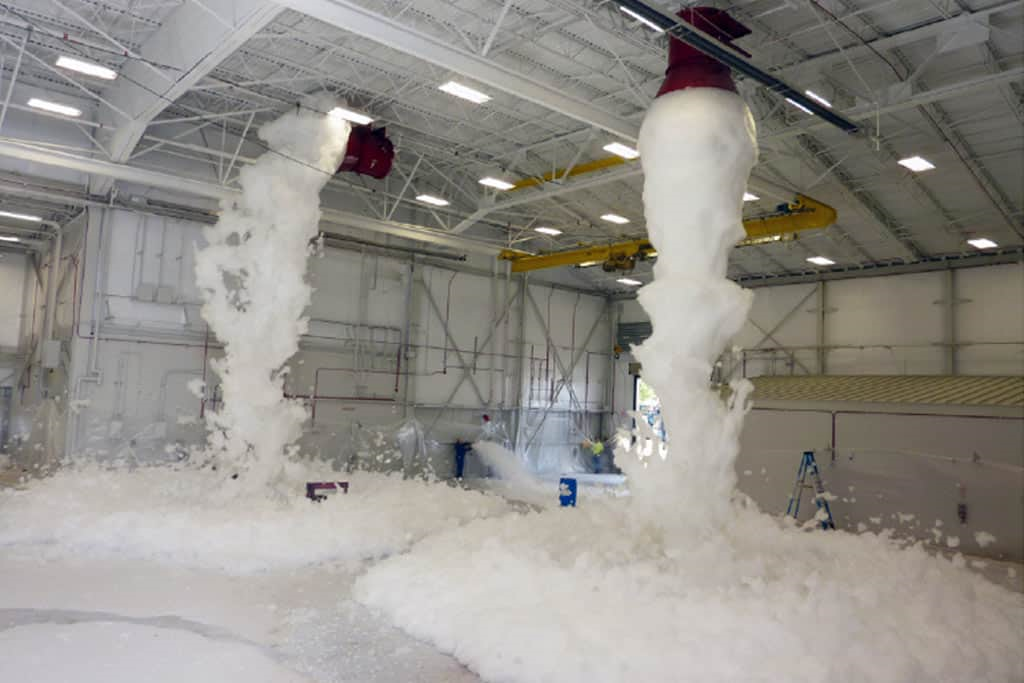Foam Based Flooding Fire Protection System

Foam Based Flooding Fire Protection System
The Importance of Foam-Based Flooding Fire Protection System for Firefighting
Introduction
Fire safety is a critical concern in industries such as oil and gas, petrochemicals, chemical processing, aviation, and others where flammable materials and volatile substances are in constant use. Fires in these industries can cause catastrophic damage, not just in terms of property, but also in terms of human lives and the environment. In these high-risk environments, fire protection systems need to be highly effective, efficient, and capable of tackling fires rapidly before they spread. One such highly efficient system is the foam-based
flooding fire protection system. This system is particularly beneficial for environments where traditional firefighting methods, such as water-based systems, may not be effective.
At Angel Safety Consultants, we understand the critical importance of advanced firefighting solutions. With our expertise in providing fire safety systems, we ensure that your premises are well-equipped to handle fire hazards effectively. In this article, we’ll explore the significance of foam-based flooding fire protection systems, their working principles, and their advantages in combating large-scale fires in industrial settings.
What is a Foam-Based Flooding Fire Protection System?
A foam-based flooding fire protection system is a type of firefighting solution that utilizes foam to suppress fires, particularly those involving flammable liquids or volatile chemicals. Unlike water-based systems, which are commonly used for general fire suppression, foam-based systems are designed to combat fires that involve fuels, oils, or other combustible liquids that cannot be extinguished by water alone.
The foam used in these systems is typically a mixture of water, foam concentrate, and air, which forms a blanket of foam when it is discharged. The foam acts as a barrier between the fire and the oxygen in the air, preventing the fire from continuing to burn. It also suppresses flammable vapors, cools the fire’s heat, and helps in preventing re-ignition, making it highly effective for fighting fires in challenging environments.
Why is a Foam-Based Flooding Fire Protection System Important?
1. Effectiveness in Combating Flammable Liquid Fires :
One of the most significant advantages of foam-based systems is their ability to fight flammable liquid fires, which are among the most dangerous types of fires. These fires, which often occur in environments that deal with oils, chemicals, or petroleum products, cannot be extinguished with water. Water can cause flammable liquids to spread, worsening the fire situation. Foam-based systems, however, are highly effective in dealing with such fires. The foam blankets the surface of the flammable liquid, cutting off the supply of oxygen and preventing the fire from continuing.
The ability of foam to form a protective layer on the surface of burning fuels is what makes this system ideal for use in industries like oil refineries, petrochemical plants, and aviation fuel depots.
2. Prevention of Re-Ignition :
After a fire is extinguished, there’s always a risk of re-ignition. This can happen when the fire has not been completely suppressed or when the heat from the fire reignites the flammable vapors or liquids. Foam-based systems help prevent re-ignition by creating a durable blanket that remains on the surface of the fuel, effectively sealing off oxygen. Additionally, the foam’s cooling properties help reduce the temperature, further minimizing the chance of the fire reigniting.
3. Fast and Efficient Fire Suppression :
Foam is incredibly effective in suppressing fires quickly. In high-risk industries, where a fire could cause extensive damage within minutes, it is crucial to act quickly to contain and suppress the flames. The foam’s ability to rapidly cover large areas and form a protective layer makes it highly efficient in suppressing fires in both open areas and confined spaces. This is particularly important in scenarios where fire spreads quickly and containment is needed immediately.
For example, in aircraft hangars or fuel storage facilities, foam-based flooding systems can suppress a large-scale fire within seconds, preventing the fire from spreading to other areas and causing widespread destruction.
4. Environmental Protection :
Fires involving hazardous materials or fuels pose a threat not only to life and property but also to the environment. The toxicity of the smoke produced during such fires, as well as the potential for chemical spills, can lead to long-lasting environmental damage. Foam-based systems help mitigate these risks by not only extinguishing the fire but also preventing harmful chemicals from being released into the environment.
The foam used in these systems can be engineered to be more environmentally friendly, with biodegradable agents that break down after use, reducing the environmental impact compared to traditional firefighting methods.
5. Versatility and Wide Application :
Foam-based flooding fire protection systems are highly versatile and can be used across various industries, including oil and gas, aviation, chemical manufacturing, shipbuilding, metalworking, and mining . These industries deal with high-risk fuels and chemicals, and foam-based systems are tailored to meet the unique needs of these environments.
For instance, foam-based systems are commonly installed in fuel storage tanks, chemical processing plants, and even in large warehouses that store flammable materials. Their ability to be customized to meet the specific needs of different industries makes them an ideal choice for providing comprehensive fire protection.
How Does a Foam-Based Flooding Fire Protection System Work?
A foam-based flooding fire protection system consists of several key components working together to combat fires:
1. Foam Concentrate :
This is the primary agent used in foam-based systems. It is a concentrated liquid that, when mixed with water, creates foam. Foam concentrates are specially designed to be compatible with different types of fuels and are available in various formulations, including alcohol-resistant foam and aqueous film-forming foam (AFFF).
2. Water Supply :
The system requires a water source that is pressurized and used to mix with the foam concentrate. The water helps to dilute the foam concentrate, creating the foam solution.
3. Foam Generating Equipment :
This includes foam chambers, monitors, and nozzles that are responsible for releasing the foam. The equipment disperses the foam across the fire-affected area, ensuring complete coverage and effective suppression.
4. Detection and Activation System :
The foam-based system is often integrated with fire detection systems that can sense the presence of a fire and trigger the foam discharge automatically. This ensures that the fire protection system activates immediately when needed.
5. Discharge System :
The discharge system directs the foam to the affected area. In a flooding system, foam is typically spread across the area in a blanket-like formation, covering the entire fire zone and effectively suffocating the flames.
Advantages of Foam-Based Flooding Fire Protection Systems
1. Quick and Effective Response :
The ability to rapidly deploy foam over large areas makes this system ideal for use in high-risk environments where a fast response is critical.
2. Reduced Water Damage :
Unlike water-based systems that can cause damage to equipment, electronics, and structures, foam-based systems are designed to minimize water damage while still suppressing the fire effectively.
3. Enhanced Fire Suppression for Flammable Liquids :
Foam is highly effective at controlling fires involving flammable liquids and fuels that are difficult to extinguish with water alone.
4. Cost-Effective for Long-Term Protection :
While the initial investment in a foam-based system may be higher than traditional firefighting systems, the long-term benefits, including reduced damage, re-ignition, and operational downtime, make it a cost-effective solution.
5. Fire Safety Compliance :
Many industries, especially those dealing with hazardous materials, must adhere to strict fire safety standards. Foam-based systems help meet these regulatory requirements and ensure compliance with industry standards.
Key Considerations When Choosing a Foam-Based Fire Protection System
• Type of Foam :
Different foam concentrates are required for different types of fires. It’s essential to choose the right type of foam concentrate based on the specific materials present in the facility.
• Area of Coverage :
The size of the area that needs to be covered by the foam system will determine the size of the system and the amount of foam concentrate required.
• Maintenance and Inspection :
Regular maintenance and inspection are essential to ensure that the system functions correctly when needed. Foam concentrate must be checked for degradation, and the equipment should be tested for proper operation.
• Environmental Impact :
The environmental impact of foam used in firefighting systems is a growing concern. Choose foam concentrates that are biodegradable and environmentally friendly, to minimize the long-term ecological impact.
Foam-based flooding fire protection systems play a critical role in ensuring the safety of industrial facilities dealing with volatile and flammable substances. By effectively combating fires involving liquid fuels and chemicals, preventing re-ignition, and providing a rapid response, these systems help mitigate the risks associated with industrial fires. Angel Safety Consultants is committed to providing advanced firefighting solutions tailored to your needs, ensuring the highest standards of safety and compliance. Contact us for more information on our foam-based flooding fire protection systems and how they can safeguard your facility from fire hazards.
